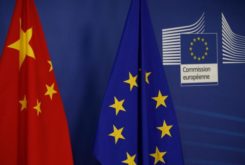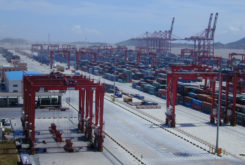On Monday (February 18) the Chinese government unveiled its blueprint for a “world-class city cluster” in the southern province of Guangdong and the adjoining Special Administrative Regions (SARs) of Macao and Hong Kong.
This was the Outline Development Plan for the Guangdong-Hong Kong-Macao Greater Bay Area (GBA), that was under preparation for more than two years.
“By 2022, the framework should essentially be formed for an international first-class bay area and world-class city clusters that is vibrant and highly innovative, with an optimized industrial structure, a smooth flow of various factors and a pleasant ecological environment,” the plan said.
“China aims to build a globally competitive modern industrial system for the GBA. Efforts will be made to expedite the development of the advanced manufacturing industry, nurture and strengthen strategic emerging industries, expedite the development of modern service industries and vigorously develop the marine economy … China aims to develop a quality living circle for living, working and travelling in the GBA,” it said.
“Measures should be taken to enhance the international competitiveness of the Pearl River Delta port cluster, develop a world-class airport cluster, ensure the smooth flow of comprehensive external transport links, build a rapid transport network in the GBA and raise the standards of passenger and cargo transport services,” it said.
The GBA plan set out a timetable to build the framework for the bay area and city cluster by 2022. The next milestone will be 2035, when markets within the bay area will be highly connected.
The GBA consists of the two SARs and nine cities in Guangdong – Guangzhou, Shenzhen, Foshan, Dongguan, Zhaoqing, Jiangmen, Zhongshan, Zhuhai and Huizhou. Its GDP in 2017 was US$1.5 trillion. It is the most developed area of China, with the highest levels of foreign investment and per capital incomes. Morgan Stanley Asia estimates that, by 2030, its economic output will double to between US$3.2 trillion and US$4.1 trillion, surpassing the GDP of Britain.
Beijing wants the GBA to become an international collection of cities that can equal Greater Tokyo, Greater New York and Silicon Valley, in terms of manufacturing, economy and technological prowess.
The plan designates Hong Kong, Macao, Shenzhen and Guangzhou as the four “key cities” and “core engines for regional development”.
The plan promises to “consolidate and enhance Hong Kong’s status as an international financial, transportation and trade centre, as well as an international aviation hub.” Macao will be a tourism hub and platform for trade with Portuguese-speaking countries.
Guangzhou will take a leading role as a provincial capital and national central city. Shenzhen’s role will be a special economic zone and home of China’s innovation and technology giants.
Carrie Lam, Chief Executive of Hong Kong, said that the plan would expand the space for living and development of Hong Kong residents.
“As a highly open and international city, Hong Kong can extend its international connections and experiences to the mainland and help bring in foreign investments. Hong Kong can also join hands with mainland enterprises to develop overseas markets and explore development opportunities,” she said.
The Macau government said it will spare no effort to implement initiatives explained in the Outline Development Plan for the Guangdong-Hong Kong-Macao Greater Bay Area, following the blueprint’s official publication by the Central Government.
“Complementary and coordinated partnership with other Greater Bay Area cities would create a more favourable environment for Macao in realising its goal of adequate economic diversification.” the government said.
But several uncertainties hang over these ambitious plans. One is the future of Sino-U.S. relations. Bilateral talks on resolving issues like the U.S.’ enormous deficit, forced transfer of technology and protection of intellectual property are not going smoothly. The U.S. government may impose higher import tariffs on Chinese imports.
Chinese technology giants like Huawei Technologies and ZTE Corporation, both based in Shenzhen, remain heavily dependent on components imported from U.S. companies, If the U.S. government chose to limit or ban such imports, the firms would be severely affected.
Another obstacle is the fact that the GBA is unlike Greater Tokyo, Paris or New York. In these three, citizens can move freely from one part to another. Mainland citizens cannot move without restriction to Hong Kong and Macao; they require a visa.
The legal, administrative and social systems in the mainland and the two SARs are different. Many Hong Kong people are ready to work in the mainland but do not wish to settle there. They prefer the legal system, medical services and way of life in Hong Kong.
A third problem is that of competition. The GBA has four international airports – Guangzhou, Shenzhen, Hong Kong and Macao. They compete fiercely for business, both cargo and passenger. The 11 cities are also competing for investment from domestic and foreign companies.
The GBA plan aims to make the cities work together for mutual benefit. But this is often easier said than done. Cities put their own interests above that of the region.
For example, at the end of January, the mayor of Zhuhai announced a plan to build a 46.5-kilometre bridge across the Pearl River to Shenzhen, with a road and rail link. If this happened, it would severely affect traffic on the new Hong Kong-Zhuhai-Macao bridge that opened in October 2018, at a cost of more than US$17 billion. (CLBrief)



